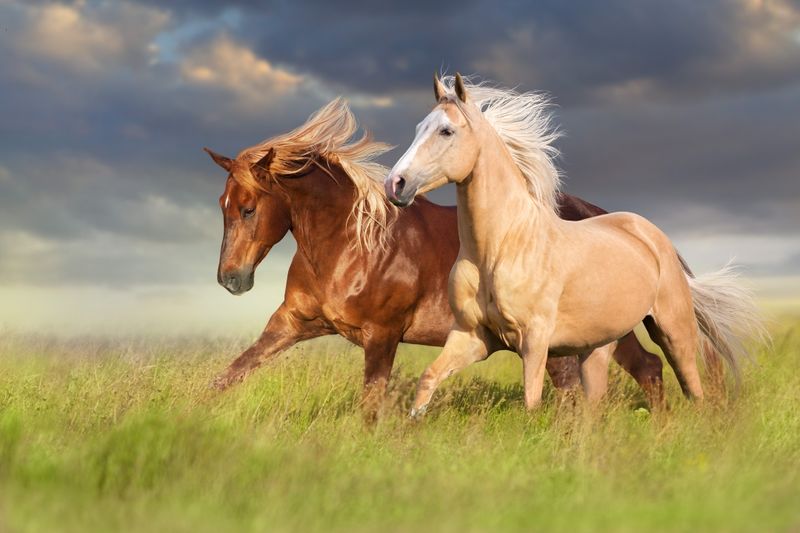A Coat of Many Colors
Hues of the Horse World


As autumn paints the landscape in brilliant shades, it’s the perfect time to explore another world of color: horse coats. There’s much to learn about equine coat colors and the genetics behind them. While it’s a complex topic, let’s discuss the basics.
The Basics of Horse Coat Colors
To grasp equine coat patterns, you first need to understand the fundamentals: black and chestnut (red). Every other shade is a variation or modification of these two.
- Chestnut horses carry two copies of a recessive gene, which means that breeding two chestnut horses will always result in a chestnut foal.
- Black, on the other hand, is dominant over chestnut, but black horses can sometimes carry a recessive chestnut gene, which is why two black horses can sometimes produce a chestnut foal (this sometimes happens even in the Friesian breed).
- Bay horses are black horses, but carry an agouti gene, which restricts the black only to their points, while their bodies are a rich reddish-mahogany color.
- Grey is a modifying gene that lightens the coat over time, and as the horse ages it typically grows lighter and lighter until it is completely white. But because grey is a modifying gene, the horse has a base coat color at birth, and that can be any color. A grey horse must have at least one grey parent.
- Roan is a modifying gene that appears along with the base coat color. This is why horses can display a variety of shades, including black roan and chestnut with intermixed white hairs. Like greys, roan horses must inherit the trait from a parent.
Common (and Not-So-Common) Colors and Patterns
Roy Rogers and his golden horse, Trigger, brought palomino horses into the Hollywood spotlight decades ago, but equine enthusiasts have long loved the allure of palominos.
A palomino is actually a chestnut horse that carries one copy of the cream gene. A buckskin (which has a golden coat like a palomino only with black points and a black mane and tail) is a bay horse with one copy of the cream gene. A black horse with one copy of the cream gene is a smoky black.
But what if a horse inherits two copies of the cream gene? These are called "double dilutes" and they're accompanied by blue eyes. If the horse's base color is chestnut, it becomes a cremello. If its base color is bay, it becomes a perlino, and if its base color is black, it is called a smokey cream.
There are many coat patterns that cause white markings of various types and that's an extensive topic on its own. Extensive white body markings on an American Paint, for example, are grouped according to their pattern, and these include tobiano, overo, tovero, sabino, and others.
Sabino markings in particular are found in many breeds, including Welsh Ponies. And of course, Appaloosas are found in a variety of different patterns of markings including spotted blanket, snowcap and leopard. These patterns can appear on base coats of many colors.
Other hues that complete the equine color rainbow include dun, champagne, grullo, silver dapple and more.

Fun with Color
It's an oft-repeated adage: "A good horse is never a bad color." And while it's easy to agree with that sentiment, plenty of other folklore exists that might not be as universally agreed upon. For example, a longstanding stereotype claims chestnut mares are temperamental and difficult — a notion many horse owners dispute.
Some horse breeds are found in numerous colors, but certain breeds are closely associated with only a single color. Iconic examples include the well-known black coats of Friesian horses, the brilliant grey Lipizzan horses and the always-chestnut Suffolk Punch horses.
It’s worth noting that a horse’s coat may change with the seasons. Sleek summer coats, especially when the horse sheds out in the spring, tend to be the most vibrant. The intensity of the summer sun can cause some coats to lighten and fade over time, but it's especially noticeable in black horses. Then of course, a horse's winter coat color can be dull and muted in comparison to a rich summer coat.
The world of equine coat colors is as fascinating as it is beautiful, blending genetics, tradition and a touch of folklore. Whether your horse is jet black, shimmering palomino or a striking roan, every shade tells a story. As the seasons shift and coats change, one thing remains true: a good horse is never a bad color.
SAMANTHA JOHNSON is a writer, farm girl and the author of more than a dozen books on rural living. She lives on a farm in northern Wisconsin with a colorful herd of Welsh Mountain Ponies. You can find her online athttps://www.authory.com/SamanthaJohnson
Tags:Horse Sense

Acreage Life is part of the Catalyst Communications Network publication family.
















